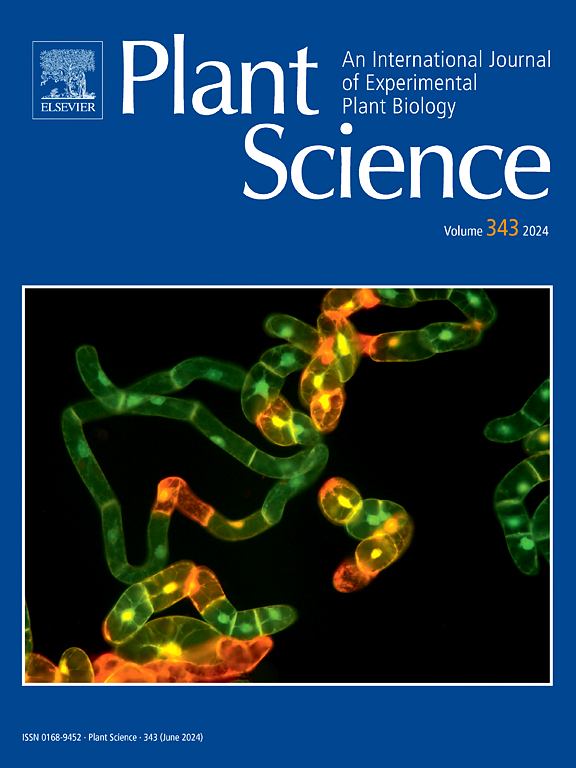The root-derived syringic acid and shoot-to-root phytohormone signaling pathways play a critical role in preventing apple scab disease
IF 4.2
2区 生物学
Q2 BIOCHEMISTRY & MOLECULAR BIOLOGY
引用次数: 0
Abstract
Apple scab is a serious disease that has a huge economic impact. While some cultivars of apple are scab-resistant, most are not. Growing research has suggested that root-derived metabolites play a vital role in conferring resistance to aboveground pathogens through the long-distance signaling system between shoot and root. In this work, leaves of scab-resistant cultivar ‘Prima’ (PRM) and scab-susceptible cultivar 'Red Delicious' (RD) were challenged by Venturia inaequalis, and the resulting metabolic reprogramming in root tissues was monitored using gas chromatography-mass spectrometry-based metabolomics in time-course fashion. Metabolomics has revealed that scab fungus causes metabolic reprogramming in underground root tissue when above-ground parts (leaves) are infected. After scab infection in the above-ground leaf tissue, syringic acid is synthesized in the root tissue and transported from the root to the aerial part through vascular tissue. The increased level of reactive oxygen species and jasmonic acid (JA) across roots suggests a signaling pathway from infected leaves triggered by hydrogen peroxide (H2O2). In this study, it was found that leaf infection with scab produces H2O2. In aerial parts infected with scab, H2O2 may act as a signaling molecule to trigger JA production. By travelling from the aerial part (shoot) to the root, H2O2 and JA act as long-distance signaling molecules, stimulating magnesium uptake, and eventually enhancing phenylalanine ammonia-lyase (PAL) activity. A metabolic reprogramming of the root tissue is initiated by H2O2, JA and PAL activity. Root metabolic reprograming results in the formation of syringic acid, which travels from the roots to the aerial part through vascular tissue and helps fight scab fungal infections. The present study demonstrated that scab infection in apple leaves is associated with long distance signaling from shoot to root, in which root-derived specialized metabolites make their way to aerial parts and confer resistance to scab.
苹果疮痂病是一种严重的病害,对经济影响巨大。虽然有些苹果栽培品种能抗疮痂病,但大多数品种却不能。越来越多的研究表明,根部衍生的代谢物通过芽和根之间的长距离信号系统在赋予地上部病原体抗性方面发挥着重要作用。在这项研究中,抗疮痂病的栽培品种 "Prima"(PRM)和易受疮痂病影响的栽培品种 "Red Delicious"(RD)的叶片受到 Venturia inaequalis 的侵袭,利用基于气相色谱-质谱联用技术的代谢组学对根部组织的代谢重编程进行了时程监测。代谢组学研究发现,疮痂病真菌感染地上部分(叶片)时,会导致地下根部组织的代谢重编程。疮痂病菌感染地上部分叶片组织后,会在根部组织中合成丁香酸,并通过维管组织从根部运输到气生部分。根部活性氧和茉莉酸(JA)水平的增加表明,过氧化氢(H2O2)是由受感染叶片引发的信号途径。本研究发现,叶片感染疮痂病会产生 H2O2。在感染疮痂病的气生部分,H2O2 可能是触发 JA 生成的信号分子。H2O2 和 JA 从气生部位(嫩枝)进入根部,成为远距离信号分子,刺激镁的吸收,最终增强苯丙氨酸氨解酶(PAL)的活性。根组织的新陈代谢重编程由 H2O2、JA 和 PAL 活性启动。根部代谢重编程导致丁香酸的形成,丁香酸通过维管组织从根部进入气生部分,有助于抵抗疮痂病真菌感染。本研究表明,苹果叶片上的疮痂病感染与从嫩枝到根的长距离信号传递有关,在这种传递过程中,根部产生的特殊代谢物会进入气生部分,并赋予气生部分对疮痂病的抗性。
本文章由计算机程序翻译,如有差异,请以英文原文为准。
求助全文
约1分钟内获得全文
求助全文
来源期刊

Plant Science
生物-生化与分子生物学
CiteScore
9.10
自引率
1.90%
发文量
322
审稿时长
33 days
期刊介绍:
Plant Science will publish in the minimum of time, research manuscripts as well as commissioned reviews and commentaries recommended by its referees in all areas of experimental plant biology with emphasis in the broad areas of genomics, proteomics, biochemistry (including enzymology), physiology, cell biology, development, genetics, functional plant breeding, systems biology and the interaction of plants with the environment.
Manuscripts for full consideration should be written concisely and essentially as a final report. The main criterion for publication is that the manuscript must contain original and significant insights that lead to a better understanding of fundamental plant biology. Papers centering on plant cell culture should be of interest to a wide audience and methods employed result in a substantial improvement over existing established techniques and approaches. Methods papers are welcome only when the technique(s) described is novel or provides a major advancement of established protocols.
 求助内容:
求助内容: 应助结果提醒方式:
应助结果提醒方式:


